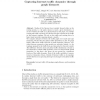Free Online Productivity Tools
i2Speak
i2Symbol
i2OCR
iTex2Img
iWeb2Print
iWeb2Shot
i2Type
iPdf2Split
iPdf2Merge
i2Bopomofo
i2Arabic
i2Style
i2Image
i2PDF
iLatex2Rtf
Sci2ools
COMPLEX
2009
Springer
2009
Springer
Capturing Internet Traffic Dynamics through Graph Distances
Studies of the Internet have typically focused either on the routing system, i.e. the paths chosen to reach a given destination, or on the evolution of traffic on a physical link. In this paper, we combine routing and traffic, and study for the first time the evolution of the traffic on the Internet topology. We rely on the traffic and routing data of a large transit provider, spanning almost a month. We compute distances between the traffic graph over small and large timescales. We find that the global traffic distribution on the AS graph largely differs from traffic observed at small timescales. However, variations between consecutive time periods are relatively limited, i.e. the topology spanned by the traffic from one time period to the next is small. This difference between local and global traffic distribution is found in the timescales at which traffic dynamics occurs on AS-level links. Small timescales, i.e. less than a few hours, do not account for a significant fraction of th...
COMPLEX 2009 | Global Traffic | Global Traffic Distribution | Theoretical Computer Science | Traffic Dynamics |
| Added | 14 Aug 2010 |
| Updated | 14 Aug 2010 |
| Type | Conference |
| Year | 2009 |
| Where | COMPLEX |
| Authors | Steve Uhlig, Bingjie Fu, Almerima Jamakovic |
Comments (0)

